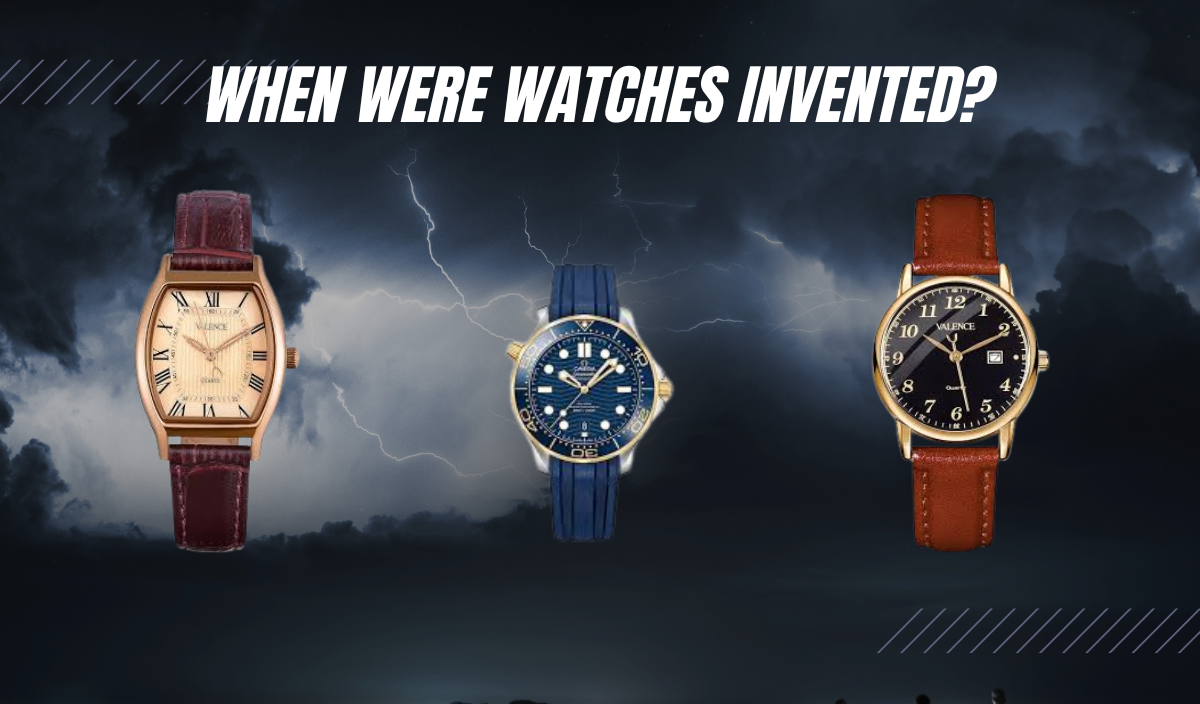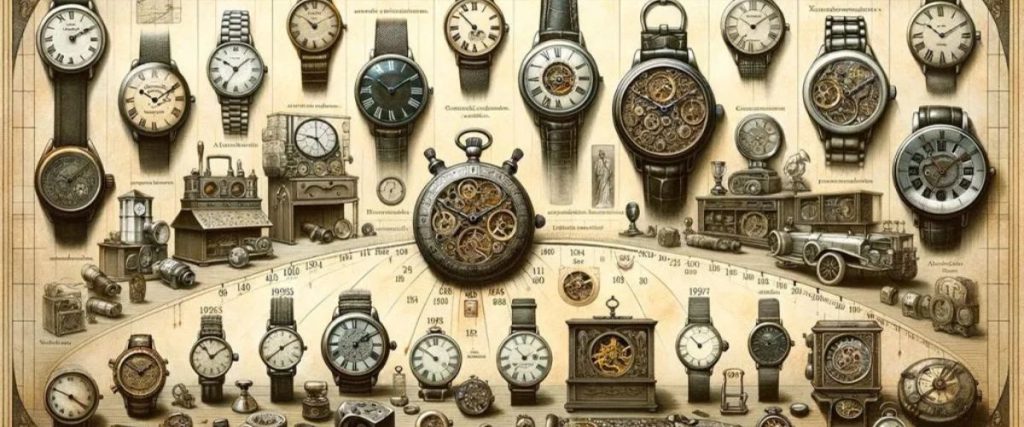
When Were Watches Invented?
It feels like watches have been around forever, especially with everyone’s growing love of vintage designs of late. But interestingly, watches aren’t as old as we might think. Compared to so many other human inventions, watches are a relatively recent addition.
Believe it or not, wristwatches have only been worn for around 100 years. And before that, timekeeping was a little more… creative.
But how did we go from tracking the time using sundials to wearing sleek, high-precision instruments on our wrists? The history of watches is more fascinating than you might think, with roots that stretch back to humanity’s earliest attempts to measure time.
From the first mechanical clocks in the 14th century to the miniaturization that allowed for pocket watches, and finally, the wristwatches that became popular in the 20th century, each step of this evolution tells a story of innovation and clever craftsmanship.
Today, I’ll be taking a closer look at the history of watchmaking, going right back to the beginning to see how it all got started. So, if you’ve just looked down at your wrist and randomly asked yourself when watches were invented, I’ve got you.
When Was The First Watch Made?

Early humans weren’t exactly checking their watches to make appointments or arrive on time for work like we do. Instead, they typically looked up to the sky and judged the time of day based on where the sun was. It’s why some of the earliest timekeeping instruments were things like the sundial, which goes all the way back to the ancient Egyptians.
They used the sun’s shadow to mark the passage of time during the day. There were also water clocks (also known as clepsydra), which the Greeks and Chinese used to track time by the steady flow of water. And let’s not forget the trusty hourglass, which appeared in medieval Europe. But more on these devices shortly.
Fast forward to the invention of mechanical clocks, and things start to look a little more familiar. One big leap came in the 17th century with the invention of the pendulum clock by Dutch scientist Christian Huygens.
This was a major breakthrough because pendulums were way more accurate than anything people had before. But, as cool as pendulum clocks were, they weren’t exactly portable!
Enter Peter Henlein, a German locksmith and clockmaker from the 15th century, who is often credited as the inventor of the first “watch.” Henlein’s creations were called “clock-watches,” and they were small enough to be carried on the body, usually in a pocket, hence the name pocket watch.
These early pocket watches, made in the 1500s, were the first step toward timekeeping becoming a personal accessory. The thing is, they were luxury items back then, reserved for the rich and fancy. It wasn’t until the late 18th century when the Industrial Revolution kicked in, that pocket watches became more affordable for the general public.
But alas, pocket watches weren’t as handy as some people would have liked. They had to be hung from clothing, usually on a chain, and often required two hands to use—one to hold the watch and the other to open the cover or read the time.
As people’s lives became busier and more fast-paced, especially during wartime, a more practical solution was needed. So what about a pocket watch… but strapped to the wrist?
When Was The First Wristwatch Created?
It’s argued that the original inventor of the first wristwatch was Abraham-Louis Breguet, a Swiss watchmaker who, in 1810, crafted the very first timepiece designed to be worn on the wrist for Queen Caroline Murat of Naples.
This wristwatch, however, was quite different from the wristwatches we know today. It was an ornate, delicate piece made for royalty. Truthfully, it was more of a piece of jewelry than a timekeeper.
For much of the 19th century, wristwatches were considered a luxury item and were mainly worn by women. Men, on the other hand, stuck to their trusty pocket watches, which were seen as more masculine and accurate.
It wasn’t until the early 20th century that wristwatches became more popular, especially for men. World War I played a significant role in this shift, as soldiers needed to quickly check the time in battle without fumbling with a pocket watch. This practicality led to wristwatches being widely adopted by the military and, soon after, by the general public.
The Evolution of Watchmaking
As we mentioned, Abraham-Louis Breguet crafted the first wristwatch in 1810, but it took some time for these designs to catch on. After World War I, however, wristwatches became the norm, and watchmakers around the world quickly followed suit, designing their own variations. With more brands jumping into the market, competition drove rapid innovation, leading to significant technological advancements.
One of the biggest innovations came in the early 20th century with the development of automatic movements. In 1923, John Harwood created the first self-winding wristwatch, which used the natural motion of the wearer’s wrist to keep the watch powered without the need for manual winding.
This was a game-changer for watch wearers since, previously, watches had to be manually wounded by hand. Now, as long as they were never taken off the wrist, they would power indefinitely.
Then came the quartz revolution. In 1969, Japanese watchmaker Seiko introduced the first quartz wristwatch, which used an electronic oscillator regulated by a quartz crystal. Quartz movements were far more accurate than mechanical ones and much cheaper to produce, leading to the widespread availability of affordable watches.
This innovation rocked the watchmaking industry for quite some time, and for a short while, it was thought that mechanical movements were gone for good. Thankfully, that wasn’t quite the case! It seems watch wearers now appreciate the precision of quartz and the traditional beauty of mechanical timepieces.
Of course, today, we’re also in the age of smartwatches. With digital displays, fitness tracking, and even the ability to make calls and send texts, these gadgets prove just how far we’ve come from the sundials of Egyptian times.
How Did People Track Time in the Past?
It’s widely believed that the world’s first timekeeping device was the sundial, with evidence suggesting it was used as far back as ancient Egypt in 1500 BCE. Yes, that’s a long, long time ago.
For it to work, the Egyptians would place a vertical stick, known as a gnomon, in the ground and observe the shadow it cast to determine the time of day based on the sun’s position.
As the sun moved across the sky, the shadow shifted, giving a rough estimate of the hour. Sundials were widely used in ancient Greece and Rome as well, but they only worked during daylight hours and, of course, required a sunny day.
To address the limitations of sundials, ancient civilizations like the Greeks and Chinese developed the water clock, also called a clepsydra. The water clock used the steady flow of water from one container to another to measure the passage of time.
These clocks were used as early as 4000 BCE in Babylon and Egypt. The Greeks later improved the design, adding gears and scales to make them more accurate. While they could be used during the day and night, they were still prone to inaccuracy due to temperature variations affecting the flow of water.
Then came the hourglass, also known as a sandglass. This timekeeping device emerged in medieval Europe, though its exact year of invention is unclear. It likely appeared in the 8th century and became popular by the 14th century.
Hourglasses work by allowing sand to flow from one bulb to another at a steady rate, measuring specific increments of time. Unlike sundials and water clocks, hourglasses were portable and more reliable, but they had to be manually reset after each use.
Conclusion
Timekeeping has come a long way from ancient sundials and water clocks. It was the brilliant Christian Huygens who, in 1656, created the pendulum clock, marking a huge leap in timekeeping accuracy.
Then, in the early 19th century, master watchmaker Abraham-Louis Breguet designed the first wristwatch, setting the stage for the stylish and practical timepieces we love and wear today. From tracking the sun to wearing time on our wrists, it’s fascinating to see how our need to measure time has shaped history. I wonder what will come next…
About Exquisite Timepieces
Established in 1998, Exquisite Timepieces is your one-stop shop for all things luxury watches! We are an authorized dealer for 60+ luxury watch brands including Omega, Hublot, Seiko, & Longines! We are proud to showcase one of the world’s largest pre-owned watch collections, including renowned brands like Rolex and Patek Philippe. Check out our brand new watch arrivals here and popular pre-owned listings here.











